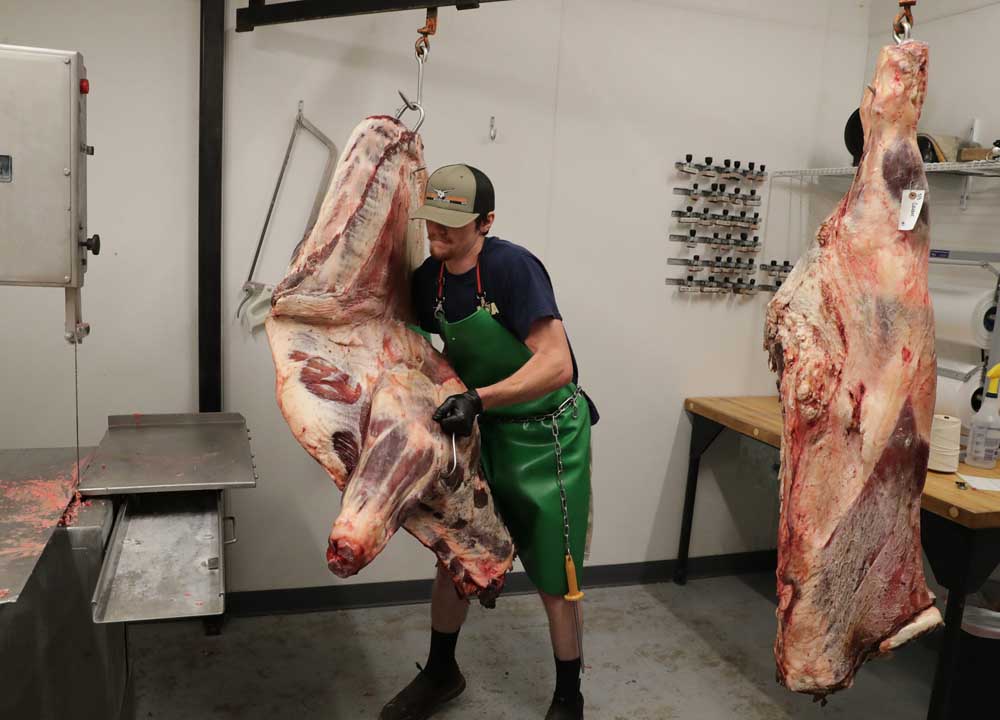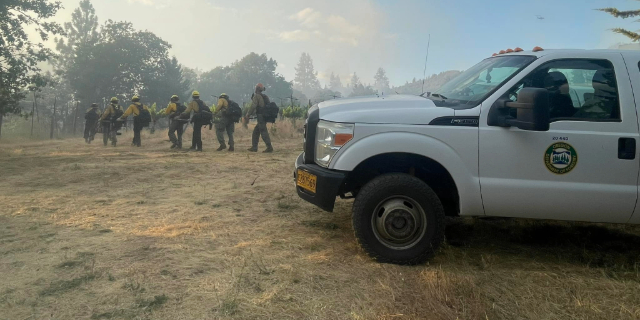Mobile butcher strives for ‘clean, efficient and painless’
Published 6:00 am Wednesday, May 31, 2023

- Kestan Brooks begins processing livestock at Nate's Custom Farm Butchering in Eagle Point.
A sign outside the front door of Nathan Petersen’s home in Eagle Point reads, “An old bear and his little honey live here.”
A few steps away is a pile of sun-whitened antlers. Even from there, the iron scent of blood is unmistakable. It comes from a little shop in the corner of the backyard where Petersen slices what recently was a cow into T-bone steaks.
Nate’s Custom Farm Butchering offers a special service. With a custom butchering truck, Petersen goes out to the farm and harvests — or as he prefers to say “dispatches” — livestock right there in the field. Sometimes people have a suspicious, even visceral reaction to his work, but Peterson believes it’s a better alternative to slaughterhouses.
“Unfortunately, a stun gun like they’d use in a commercial setting, most people’s animals aren’t that tame. We dispatch ’em with a rifle, we bleed ’em, we back up and we do all our work right there on the truck — we skin ’em, gut ’em, quarter ’em and they hang in here just to get back to the shop,” he said, leaning on his butchering truck.
Petersen has kind eyes and large hands. He wavers between shy and soft-spoken. He can “dispatch” from five to 15 animals a day — from cows to pigs to sheep. Although he mostly refers to cows as “beefs.”
He dispatches other animals too: goats sometimes; yaks from a farm in the hills of Ashland; and occasionally bison.
From the outside, his trailer looks like many others. He opens a compartment behind the passenger door to reveal several blue plastic 55-gallon barrels — for the guts, he said. A single cow can easily fill one barrel with offal.
This is the worst part of the work, he said, the mess and the waste. There isn’t a local facility to process the organs. Unless a farmer wants livers and hearts or has a big compost pile, “there’s nowhere for it but the landfill,” he said.
Behind a rolling door on the back, most of the trailer’s interior is shining stainless steel. A couple sets of butcher’s knives in plastic sheaths hang from a chain near the back, with hooks near the ceiling on either side. The trailer is equipped with a crane capable of rising 20 feet up to accommodate even the largest animals.
Petersen has been a butcher for 20 years, ever since he was 18 years old fishing in Alaska in the summers and needed a winter job to stay there, he said. A self-described “big hunter,” the trade was an easy fit. But since discovering farm butchering, he looks at his own trade with a critical eye and high ideals.
“I think a lot of people see things like Food Inc., and it makes you not want to eat. It makes you want to know where your food comes from. I do. I never thought about it. I was a grocery store butcher for 13 years. I never thought much about it at all until I started doing this part of the trade, and I realized how much cleaner it is, all the benefits,” he said.
Petersen prefers his way of turning cows into burgers, because the meat tastes better when animals aren’t tensed up through the slaughterhouse, he said.
“They take these animals from big pastures or feedlots and they load ’em into trailers — which they don’t ever ride in trailers — and put ’em in this concrete setting, which is not natural for them. You can imagine the stress for those animals. When we dispatch an animal with a rifle, yeah, it might sound a little brutal, but they’re walking around out here in their home. They have no idea,” he said.
His soft-spoken voice changes when he talks about animal welfare. His face lights up. He approaches their death with a passion for tenderness. A shot to the brain is an instant death, he said — no fear and no pain. He’s thoughtful for his clients, too, the owners who raised the animals. He said he always offers the option to walk away while he does the deed.
“Sometimes they say, ‘No, I need to be part of this, this is what I’m doin.’ I’ve seen people cry. I try my best to make it clean, efficient and painless so nobody suffers. They can at least have that with those animals,” he said.
The animals Petersen is “dispatching” are largely from small farms. He estimates about half of his customers are subsistence farmers raising their own meat. The other half are the same, except they’re raising a few extra animals to sell and cover feed costs. In a sense, he explained, current laws limit his work to these customers, with the exception of exotic animals.
“In the world we are in, it’s custom exempt. All we (farm butchers) are allowed to legally do is process,” he said.
The United Stated Department of Agriculture mandates all meat sold in stores and even farmers markets has to come from animals inspected and slaughtered in a USDA facility, he said. Only exotic animals such as yaks and bison are exempt; exotics can be farm slaughtered and commercially sold.
The meat sold from Petersen’s work is often part of a kind of underground farm economy, he said, like the way eggs or milk are sold through signs and self-service stands along country roads throughout Oregon. These products are traded and bartered between farmers or quietly sold between friends and neighbors.
“Other than the law, people are doing it all the time. But who’s going to police that law? Who’s going to say, ‘You can’t sell that meat to your neighbor?’” he said.
Legally, he can have no part in those sales. For his part, his work begins with dispatching the animals and ends when he gives the packaged meat to the client.
Compared to the care he brings to his work, he looks on slaughterhouses with suspicion. Those animals are likely to suffer. They don’t go out quietly at home with no knowledge or pain.
“The sad part is that if people really looked at it, they’d realize how crappy it really is. And it doesn’t need to be like that. I think they should let up on the laws and let us come to do it how we do it, and then these customers could sell to everybody, have their own little farm stands,” he said.
His company is three years old and only employs himself, one employee and his wife, Stefani Petersen.
“She’s the boss lady. I’m just a worker,” he said of Stefani.
Even with the “real small niche” they operate in economically, they’re routinely booked two to three months in advance through most of the year, he said. In the fall, when the animals are fat and winter will soon cut off their food supply, the demand is even greater.
In the past three years, he said, he has seen the number of small farms and subsistence operations grow and diversify throughout the valley. There are enough of them to support himself and two competing farm butchers in the valley, even though none of the meat they produce — except exotics — can be sold commercially.
He acknowledged people “aren’t lining up to be butchers.” He sometimes worries he’ll be harassed for driving a truck with a butcher’s logo on the side. But he stressed he has an open door for anyone to see any part of his work, because he doesn’t believe in hiding. That only means there’s something to be ashamed of.
“A lot of people think you’re probably a little off your rocker, to go out there and butcher animals on the regular. We’re not terrible people. The problem is everybody’s so detached from it. They don’t realize that somebody’s got to go kill that animal. Whether it be the slaughterhouse or the farm kill guy,” Petersen said.






